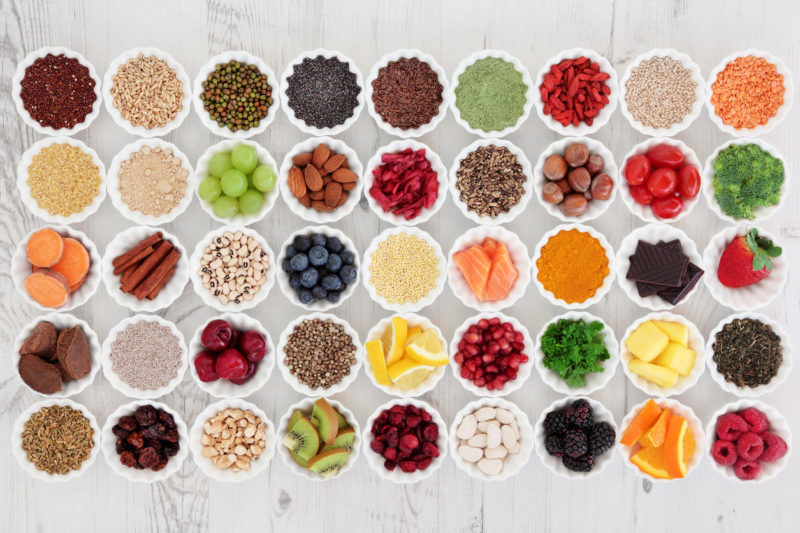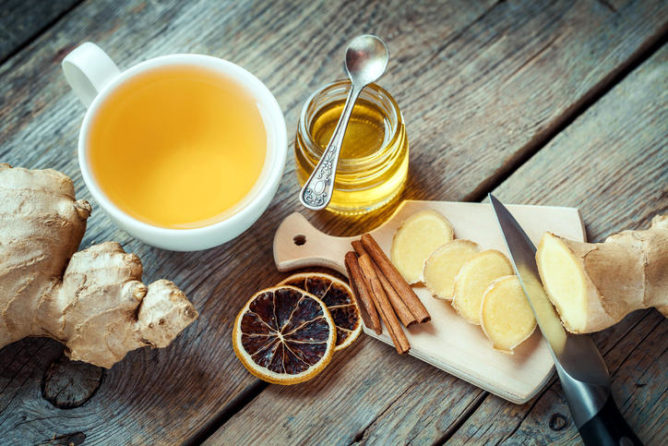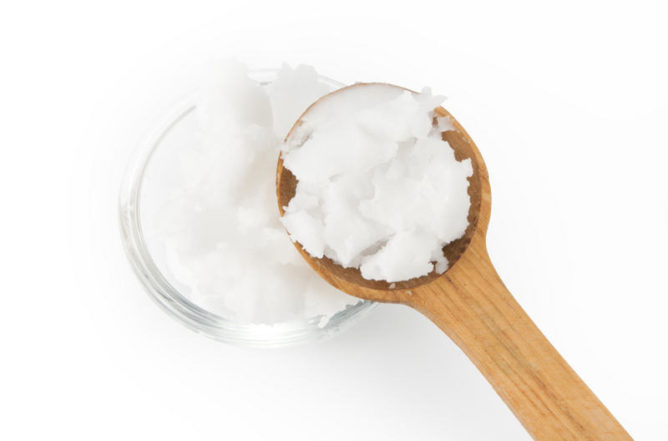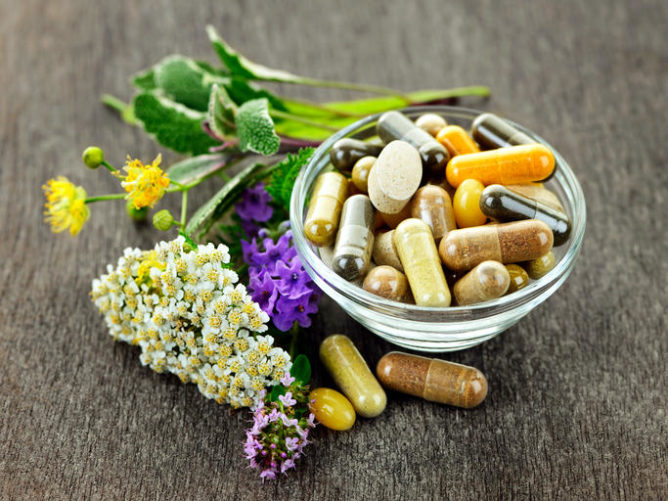Natural First Aid Kit For Home and Travel

Whether we’re home or abroad, many of us are used to opening the medicine cabinet or the first aid kit for solutions to what ails us. Over-the-counter medications and remedies are often the quick and easy option, but they also contain a plethora of harmful ingredients that don’t support our health. That’s why I rely on my Nutritionist’s Natural First Aid Kit when I’m at home and when I’m traveling.
In 2016 alone, Americans spent $34 billion on over-the-counter medications (OTCs). In case you’re wondering, that number in 1965 was $2 billion. In the last 50 years, we’ve clearly increased our dependence on OTCs and research indicates that over 80% of adults use them as a first response to ailments and injuries.
The most popular OTCs include pain relievers, cough and cold medications, allergy medications and laxatives (because pooping, or lack of poop I should say, is a huge issue). I’m sure you’ve probably used one of these at some point, or maybe you still have them in your cupboards.
While using OTCs may seem innocuous, they’re really not. Even if the ingredients (both medicinal and non-medicinal) are government-approved, we are not consuming these medications in isolation and we’re not merely using them once in awhile or for an emergency. We’re reliant on them and the risks can include:
- OTC Drug Addiction. The medicinal ingredients used in OTCs are powerful. Consumers can become addicted to them and rather than dealing with the root of the problem, they continue to use OTCS as a band-aid. For example, this is a concern with laxatives – we use them to the point where we can’t poop on our own.
- OTC Abuse. Sometimes, we take an OTC for a different reason than it was originally designed for, or we use them when we don’t even have a medical problem. In one survey, 6.4 million people reported that they used an OTC for non-medical reasons in the previous month. Some people, particularly teenagers, take OTCs to get high or combine them with alcohol.
- Long-Term Side Effects. OTCs are not meant to be taken all the time, and yet we are relying on them and using them that way. This can lead to some serious long-term side effects, such as liver damage and gastric bleeding.
Fortunately, there are a number of natural remedies you can have on hand at home or when traveling to help with common ailments. Before I get into my Nutritionist’s Natural First Aid Kit, I’d like to point out that many of the issues we tend to turn to OTCs for can be prevented from happening in the first place with diet and lifestyle practices. As I mentioned earlier, some of the most frequently-used OTCs are for cough + cold symptoms, digestion and pain relief.
Simple Strategies For Natural Prevention
- Support the immune system on a regular basis with things like medicinal mushrooms, bone broth, ginger, garlic, onions, elderberry syrup, probiotic + fermented foods, and immune tonics. This will help you prevent colds and flus, and arm you for allergy season.
- Drink loads of water, the cleanest kind you can find.
- Supporting the digestive tract with plenty of vegetables and fruit, fibre (psyllium, chia, flax, etc.), fermented foods, digestive tonics, aloe, self-care and regular movement. The squatty potty helps a lot too! For more about digestion, you can get the full low-down on how I healed myself from Crohn’s disease here.
- If allergies are an issue, load up on Vitamin C-rich foods (citrus, dark leafy greens, bell peppers), probiotic foods and quercetin-rich foods (apples, peppers, berries, tomatoes, greens). You can learn more about delicious solutions for allergy sufferers here.
- Focus on anti-inflammatory foods to reduce pain throughout the body.
And now, let’s get down to what foods, herbs, spices and other ingredients I rely on!
Nutritionist’s natural First Aid Kit: At Home

Our kitchen cupboards are packed with ingredients that support our health! In my home, you’ll always find:
Cayenne
This spicy spice supports immune system function and increases circulation throughout the body. It can also can be helpful in healing intestinal inflammation, common in people who suffer from multiple food sensitives, and for pain relief.
How to Use It: Use it in a variety of recipes (this dahl is one of my faves). If you cut yourself while chopping, adding a pinch of cayenne will help stop the bleeding.
Turmeric
This is one of my all-time favourite spices! Turmeric is highly anti-inflammatory and its active component, curcumin, is just as effective as anti-inflammatory drugs.
How to Use It: Check out one of these 19 Ways to Use Turmeric. I’m partial to my turmeric tea recipe, but turmeric can be added to a variety of culinary dishes and used in beauty care.
Raw Honey
Raw honey has anti-viral, anti-bacterial, and anti-fungal properties and is a powerful antioxidant helping to strengthens the immune system. The antiseptic properties of honey will clean wounds, support the digestive tract and inhibit bacterial growth. It also promotes healing, reduces swelling and prevents infections.
I also like to use bee pollen and bee propolis spray is extremely helpful when I have a sore throat due to illness or when I’ve done a lot of talking at events and classes.
How to Use It: Honey can be used topically for burns and wounds, or use it in a culinary context in baked goods, smoothies, elixirs and other sweet treats.
Coconut Oil

Coconut oil is one of my favourite fats to use in the kitchen, bathroom and bedroom. Coconut oil has:
- Medium-chain fats that are easily absorbed and used for energy
- Anti-microbial and anti-fungal properties
- Anti-stress and antioxidant properties
- Helps us balance blood sugar and maintain a healthy weight
How to Use It: Use coconut oil in high-heat cooking, as a moisturizer and in other beauty care products, as a natural lubricant, in elixirs and baked goods, and in your hair. More inspiration for how to use coconut oil is right here.
Ginger
Ginger is another fantastic anti-inflammatory herb. It supports digestion, reduces nausea, alleviates pain from a sore throat, reduces cold symptoms, and stimulates the part of the immune system that produces anti-bodies, thereby amping up your body’s natural defences to foreign invaders.
How to Use It: Take a ginger bath for aches and pains, mix powdered ginger with some water and apply to your temples for a headache, drink ginger tea, use ginger in juices and tonics, incorporate it into baked goodies. You can also purchase ginger supplements.
Garlic + Onions

Garlic is fantastic for banishing symptoms of colds and flus, for supporting the immune system, and supporting cardiovascular health. Onions contain quercetin, a phytonutrient that keeps seasonal allergies at bay, as well as the immune-supportive Vitamin C and chromium, which helps to balance blood sugar. Both garlic and onions are very anti-inflammatory.
How to Use Them: As a base for soups, stews and casseroles, and in dips and spreads. If you feel a cold coming on, chop up some garlic and eat it (don’t kiss anyone right after). Garlic and onion are also used in Fire Cider, an amazing immune tonic.
Oil of Oregano
Oil of oregano is anti-viral and anti-bacterial, making a great choice for warding off colds and flus, or dealing with their symptoms. This one has a very strong flavour, so start slowly and work your way up.
How to Use It: When you feel a cold coming on, take a few drops of oil of oregano in water. You can also create a steam bath for yourself using a bowl of hot water, a few drops of oil of oregano and a towel to drape over your head. Inhale the steam to help break up and expel mucus.
Tea Tree Oil
This essential oil is incredibly anti-bacterial and anti-fungal, and it has disinfectant, antiseptic and anti-microbial properties. It really keeps those germs at bay.
How to Use It: Use tea tree oil topically for acne, foot fungus, cold sores and dandruff. When applying tea tree oil, always mix with water or a carrier oil. It can also be used to clean your home. Never take tea tree oil internally.
Epsom Salts
Epsom salts, or magnesium sulfate, are great for relaxing sore muscles, stress reduction and pain relief.
How to Use It: Mix 1-2 cups of Epsom salts in the bath and soak away. It also helps to add your favourite essential oils.
Castor Oil
Castor oil is amazing both internally and externally. The ricinoleic acid in castor oil prevents the growth of bacteria, yeast, and viruses. It’s anti-inflammatory, great for arthritic or joint pain, helps alleviate constipation and can remove swelling and infection from any wounds including ringworm, inflammation and sunburns. Massaging the body with castor oil prior to a bath once a week will help the skin retain its natural healing properties as well as stimulate the body’s muscles and internal organs.
How to Use It: Topically, create a castor oil pack and apply to any areas that are in need of healing. To use as a topical cream for wounds, pre-soak the infected area with Epsom salts to soften the skin, then wrap the area with a cotton cloth soaked in castor oil. Rubbing castor oil on hands and feet at night will help maintain healthy and soft skin, as well as reduce callous and dry skin. When taken internally, castor oil will have a laxative effect.
Aloe
Aloe is anti-inflammatory, anti-viral and anti-bacterial. Its mucilaginous texture is great for the digestive tract and is very cleansing for our bodies. While you can buy aloe products, I prefer to have aloe plants in my home and use the leaves as I need them.
How to Use It: Use aloe topically for burns and other wounds, skin conditions like dermatitis and psoriasis, to protect yourself against UV radiation, to reduce scars, and to relieve itching. Make a skin salve to reduce redness and swelling. Internally, you can down aloe shots for digestive healing and to alleviate constipation.
Apple Cider Vinegar
Apple cider vinegar is a wonderful fermented food that helps with digestion, and is also a great one for skincare, home cleaning, bad breath, fighting fungus and more.
How to Use It: Check out these 20 awesome ways to use apple cider vinegar. Some of these may surprise you!
A Nutritionist’s natural First Aid Kit: Travel
 I adore travelling and as much as I’d like to take my kitchen with me, I can’t. So these are the things I pack in my travel bag to ensure that my health stays on track.
I adore travelling and as much as I’d like to take my kitchen with me, I can’t. So these are the things I pack in my travel bag to ensure that my health stays on track.
Digestive Enzymes with Hydrochloric Acid
This aids with digestion on the road and gives me a little extra help if I’m eating out or at someone’s house.
Shelf-Stable Probiotics
Travel exposes us to new foods, foreign pathogens in the water, and other bugs and infections we’re not accustomed to dealing with at home. Taking a good probiotic helps to maintain immunity, regularity and boost the good microflora in our digestive tract.
I like to take a high potency probiotic with me like this one. Bacteria counts in probiotics are typically measured at the time of bottling and will decline over time. Though I try and keep mine refrigerated while I’m away, starting out with a fresh, high potency option helps ensure there are still active little guys in there by the end of my trip too.
Ginger Tablets
I get severe motion sickness whether I’m in a car (even if I’m driving), plane, bus or train. I have found that ginger is one of the most consistently effective remedies for motion sickness for me. It’s essential for my natural first aid kit. I take it every two hours beginning two hours before I leave my house on a travel day and don’t stop until I land. Yes, this is a bit much but it works. As an extra bonus, they are anti-inflammatory and great for overall digestion.
Oil of Oregano
This is a great one to take along as it’s small and helps to fight any infections on the road.
Tea Tree Oil
This is a fantastic antiseptic and it also has amazing anti-viral, anti-bacterial and anti-fungal functions. It also doubles as a quick and easy cleaner when mixed with water, in case all that’s available are toxic home cleaning products.
Activated Charcoal
Activated charcoal is highly absorbent and helps to remove toxins from the body – it’s often used in a medical context to combat poisoning. When travelling, I take charcoal tablets along in case of food poisoning, stomach bugs, or diarrhea.
A natural first aid kit, whether at home or when traveling, can be a fantastic approach for troubleshooting when health issues arise. And the best part is most of these ingredients can also be incorporated into our life for health, so you can use them regularly.
Header image: iStock/marilyna
At Home image: iStock/Chamille White
Travel image: iStock/Elenathewise
Free Resource Library
Enjoy more than 40 downloadable guides, recipes, and resources.
























